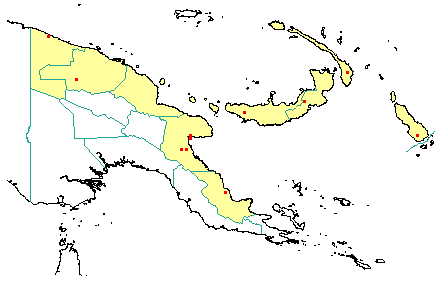
in PNGplants database
PNGTreesKey – Ailanthus integrifolia Lam subsp. integrifolia |
Barry Conn (NSW) & Kipiro Damas (LAE).
Guide to trees of Papua New Guinea
Copyright held by the authors, National Herbarium of New South Wales, and Papua New Guinea National Herbarium
Flora Malesiana, Series 1 Vol. 6: 218 (1962)
Family: Simaroubaceae
Dicotyledon
Timber Group: Minor hardwood
Field Characters: Emergent tree (up to 60 m high) or Large canopy tree; Bole cylindrical (up to 120 cm diam.); straight (bole up to 40 m long); buttresses buttresses absent; spines spines absent; aerial roots aerial roots absent; stilt roots stilt roots absent; Bark white, grey, or brown (pale sometimes), rough or rarely smooth, pustular, lenticels rounded/swelling or lenticels irregular; Subrhytidome (under-bark) brown; less than 25 mm thick, 12.0-14.0; bark blaze consisting of one layer; strongly aromatic; unpleasant; outer blaze orange or pale brown, speckled, rarely fibrous or granular without splinters; inner blaze orange or pale brown, speckled, rarely fibrous or granular without splinters; bark exudate (sap) present, colourless, not readily flowing (spotty), colour not changing on exposure to air, not sticky; terminal buds not enclosed by leaves.
Indumentum: Complex hairs absent; stinging hairs present; mature twig indumentum (hairs) absent.
Leaves: Leaves spaced along branches, spiral (leaves occurring singly at a node and arranged spirally up the branchlet), compound (a leaf made up from two or more leaflets); petiole present, not winged, attached to base of leaf blade, not swollen; leaves pinnate (unbranched with more than three leaflets); petiolule not swollen; rachis present, present, absent; leaves without a terminal leaflet (the number of leaflets even - paripinnate), broadest below middle, 8.5-13.0 cm, 5.0-6.0 cm, leaflets opposite, asymmetric (or slightly so); venation pinnate, secondary veins open, prominent, intramarginal veins absent; leaves lower surface pale green, upper surface green, indumentum (hairs) absent; present (large black glands on lower surface mostly near base); domatia absent; stipules absent.
Flowers: Inflorescence terminal, flowers on a branched axis, cones absent; flowers unisexual, unisexual with male and female flowers on different plants, stalked, flowers with many planes of symmetry, 5.0-6.0 mm long, diameter small (up to10 mm diam.) (c. 5 mm diam.); perianth present, with distinct sepals and petals whorls, inner perianth pale yellow or green; 5, some or partly joined; stamens 10, present, free of each other, joined to the perianth; ovary superior (female flowers), carpels separate (when more than one), locules 5; styles free, 5 (1 per carpel).
Fruits: Infrutescence arranged on branched axis, fruit 110.0-220.0 mm long, brown, not spiny, non-fleshy, simple (by misinterpretation) or aggregate, indehiscent, samara; seeds 1-(by misinterpretation)-5, much more than 10 mm long (seed c. 15 mm long, excluding wing) or 100 mm long or much longer (110-220 mm long when wing included), winged (usually at least 50 mm long), broad (as wide as long) (flattened), seed more than 10 mm diam. (10-15 mm diam.).
Distribution: West Sepik, East Sepik, Madang, Morobe, Northern, New Britain, New Ireland & Bougainville.
 | Botanical records in PNGplants database |